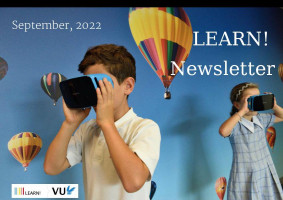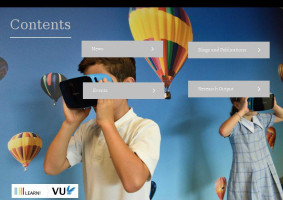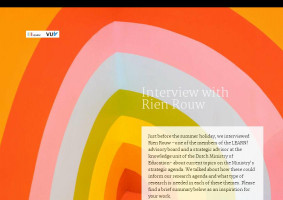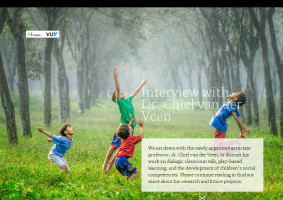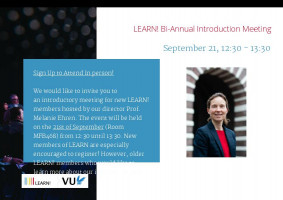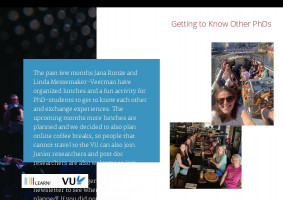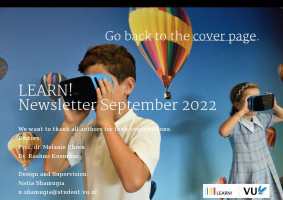(1)_w420_h438_1.jpg)
As some of our readers already know, your research focuses on dialogic classroom talk in primary and higher education, play-based learning, and the development of children's social competencies (including oral communication, theory of mind, and social status). Why THESE TOPICS?
It was a bit of a coincidence. I never planned to do research in the first place. During high school, I focused on science and technology and was planning to work in this area. But I was not a good student back then: I skipped classes and wasn’t really motivated. After some reflection, I decided to enroll in a teacher training program as a way to change the system from within. There, I was introduced to science, language learning, child development, and psychology. As it turned out, I was not too fond of this training either, seeing how it included many assignments and classes. I almost dropped out. Thankfully, I changed my mind after enrolling in a student group, which introduced me to the practice of science by way of journal clubs, visits to innovative schools and a student-assistantship. Eventually, I realized that working in schools and reading scientific articles was something I enjoyed and did well. Thus, I continued my academic journey by studying educational sciences and philosophy. Finally, a VU supervisor offered me a Ph.D. position exploring classroom conversations in early childhood education. The topic turned out to be very interesting. It was fascinating how honestly children conversed with others and how easy it was for them to take the perspective of another kid. Thus, I kept on researching classroom conversations.
What is dialogic classroom talk?
Classroom conversations vary on a continuum of monological to dialogical. Monological classroom talk is overly teacher-steered and based on reciting knowledge. On the other side of the spectrum is the dialogical conversation with open and authentic questions,group reasoning, sharing ideasand listening to one another. Although some researchers in the field of classroom conversation are focused on the topics of agreement and convincing within conversations, I am more interested in how understanding comes about.
What does dialogic classroom talk research look like?
In the seventies and eighties, researchers started to observe teachers using dialogic classroom talk to extract useful techniques and create models for other teachers to use. During my PhD, we weree on of the first in our field to conduct a quasi-experimental study on the effects of dialogic classroom talk. Nowadays, however, the research into dialogic classroom talk comprises mixed methods: large-scale quantitative RCTs with measures on the level of children and classroom observations.
How does dialogic classroom talk benefit CHILD development?
In multiple ways. It is helpful for communication and language development. We also have some research that focuses on more specific learning outcomes. For example, we see that in classrooms, where teachers ask more open and authentic questions, students perform better even on standardized tests of English, Math, and Science. We also see changes that develop over more extended periods of time, such as a sort of transfer from these conversations to play-based activities in which students are more attuned to one another, ask more questions, and try to take the perspective of the other. In addition, we see some changes in the social climate in the classroom. But this is really preliminary and we need more longitudinal research to understand the mechanisms of this change.
How widely established is this method In The Dutch education system?
I do not think it is very widely established. However, we have done some work to deliver it to teachers: we have written practice-oriented articles and given many workshops and conferences for teachers. As a result, there is quite a lot of interest in it. We see a lot of enthusiasm in teachers who want to implement this method throughout their entire curriculum. Interestingly, the uses of dialogic classroom talk are fairly varied: some teachers use this method to talk to parents or even teach at church schools.
What is the most optimal way to incorporate dialogic classroom talk in the daily classroom life?
There is no optimal way. The use of dialogic classroom talk is very much context-based. There are instances where dialogic classroom talk may be too difficult, such as when teachers struggle with classroom management. In general, we suggest that teachers build up a dialogic classroom culture by trying one or two techniques, recording, and observing themselves. An essential strategy for effectively implementing dialogic classroom talk is pausing after questions, which is necessary to support children's thinking. The underlying idea is that if a teacher is silent for 5 seconds after posing a question, every student has had the opportunity to think of an answer even if they are not vocally participating. It turns out to be a common misconception among teachers that they think they pause after questions when actually they do not (which they can see via video self-evaluations). What teachers appear to do instead of pausing after questions is to repeat the questions, sometimes using different words, or pose five or six additional questions. Such interaction patterns are important for teachers to monitor.
What is the added value of play-based learning in modern education?
Every kid plays. It is a cultural activity that we see everywhere In the setting of education, it is a context in which learning can take place. Some people think playing is something you do to relax after the hard part of learning. But I think these two can be combined. For learning to take place, it needs to meet certain parameters. First, in every play activity, there are some rules a child needs to follow. For example, if children are role-playing, they need to follow some social rules that are related to their role, e.g., a cook or shop owner and behave accordingly. But there are also degrees of freedom to perform these roles according to one's own motives, interests, imagination, etc.. These degrees of freedom constitute the second aspect of play: one can be a cook, but one can also come up with the specific dish one wants to cook. The third aspect of play is that there is always a high level of involvement on the part of the children.
For the play activity to be successful in the educational setting, teacher sensitivity and responsivity is required: a teacher must observe the play activity and know when to interfere to broaden or deepen the play. This is where learning can take place. What I would like to know next is how one assesses whether the play-based learning has an added value.
How does one quantitatively or qualitatively assess whether Play-Based learning supports children’s learning and development?
A lot of research shows the benefits of play for child development. Needs a sentence. What you see in very young kids is they manipulate objects and are object-oriented. By doing so, children develop, for example, spatial language skills. As soon as children begin to build structures with objects, they learn words such as "before", "after", "on", "outside", etc. Object manipulation also benefits children's motor development. Evolutionarily, as a species, we need to play with objects in order to survive and to explore our surroundings. Later on, during child development, children become more interested in social relations and we can see an increase in role-play. Role-play supports children's language and social development, for example the development of their theory of mind. These benefits arise because, during role-play, a child relates themself to others, taking the perspective of the chosen role.
Together with one of my PhD students (Jannette Prins), we have compared role-playing outside, in a nature-based environment, to role-playing in a paved environment such as a schoolyard, with concrete, a swing, and a sand pit. What we see is that in a nature-based environment, children's play becomes richer, with the use of more complex language, and negotiation. A possible explanation might be that the nature-based environment is more conducive to creative play since it is much less fixed than the paved environment. For example, what a child can do with a sandpit and a bike is more or less fixed. But, on the other hand, discussing the function of a stick or stone found in the context of a play activity in a nature-based environment requires more negotiation.
Nowadays, play is under pressure from formal learning. People see play as a way to relax, whereas formal education is becoming more and more prominent even in young kids. Already at two years of age, school children need to complete assignments and tasks that take time away from playing. Thus, some researchers are worried that play as a context in which learning can take place will be taken over by more formal learning, prompting the research into the added value of play in children's learning and development.
What other factors are there that influence the development of social and oral communicative competencies in children?
Social competencies and oral communication skills are multifaceted. For example, oral competencies include vocabulary, turn-taking, perspective-taking, and, more broadly, social-cultural skills, which are required to participate in today's society filled with polarization. The notion underlying my research is that supporting the r development of social and oral communicative competencies are necessary for raising the democratic citizens of the future.
In line with this notion, what I see in dialogical classroom talk is that it supports children in dealing with diversity and different perspectives. The same happens in play activities. But there are also other, less intuitive ways to promote social competencies in children, for instance, via listening and employing silence. Sadly, in today's classrooms, there is much more noise and appreciation of vocal participation. Of course, every student should have the opportunity to be vocal during class and share their ideas, but we should also emphasize the benefits of silence, which is an important practice that helps to understand the other.
What (other) projects do you have on the way?
There are a lot of projects on the way. My colleagues Femke van der Wilt, Anne de Bruijn, Martijn Meeter and I have obtained two grants of 350k each to evaluate some possibly effective interventions that can be used by primary schools to address the decrements in development and learning caused by the COVID-19 crisis. One project we have planned is an RCT evaluation of an intervention in early childhood education, especially focused on second language learners. The other project is an RCT evaluation of a program designed to support physical education in primary schools. I would also like to employ eye tracking in classroom talk research to see how teachers allocate their attention during dialogic classroom talk.
What is the overarching goal of your research?
Maybe I want to render educational sciences irrelevant. Ultimately, through research, we want to improve, optimize or innovate the educational practice to the degree where educational sciences would become obsolete. While we work toward this goal, I want to remind other researchers that educational sciences should maybe work in the service of the practice of education, and this service should also be reflected in how funds are allocated. I just hope that not too much money goes to educational sciences and is instead mainly directed at the practice of education, ideally to teachers in order to give them time and space to teach and improve their practice.
